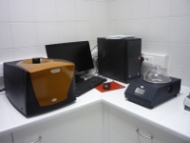Differential Scanning Calorimetry (DSC) is a thermoanalytical technique that measures the heat absorbed or released by a sample as it is heated or cooled. DSC is widely used for the thermodynamic analysis of biomolecules and nanoparticles.
Application examples:
- Protein stability and folding
- Binding interactions: Protein-ligand, Protein-Protein/Lipid, Drug-Lipid or Drug/protein-DNA
- Characterization of membranes, lipids, nucleic acids and micellar systems
Our TA™ Nano DSC has the versatility and precision for characterizing molecular stability, determining high affinity ligand binding and deconvoluting multi-domain structures. It is a powerful thermal scanning instrument that utilizes a 300 µL capillary cell design and solid-state thermoelectric temperature control to provide unmatched performance. The NanoAnalyze™ software provides a quick and easy data analysis.

Recent publications with our TA™ Nano DSC:
Bragança, P. M. S. et al. Incorporation of a molybdenum atom in a Rubredoxin-type Centre of a de novo-designed α3DIV-L21C three-helical bundle peptide. J. Inorg. Biochem. 240, (2023).
https://doi.org/10.1016/j.jinorgbio.2022.112096
Correia, V. G. et al. Mapping Molecular Recognition of β1,3-1,4-Glucans by a Surface Glycan-Binding Protein from the Human Gut Symbiont Bacteroides ovatus. Microbiol. Spectr. 9, 1-18 (2021).
https://doi.org/10.1128/Spectrum.01826-21
Nóbrega, C. S., Devreese, B. & Pauleta, S. R. YhjA - An Escherichia coli trihemic enzyme with quinol peroxidase activity. Biochim. Biophys. Acta - Bioenerg. 1859, 411-422 (2018).
https://doi.org/10.1016/j.bbabio.2018.03.008
More publications
Differential Scanning Calorimetry (DSC) is a thermoanalytical technique that measures the heat absorbed or released by a sample as it is heated or cooled. DSC is widely used for the thermodynamic analysis of biomolecules and nanoparticles.
Application examples:
- Protein stability and folding
- Binding interactions: Protein-ligand, Protein-Protein/Lipid, Drug-Lipid or Drug/protein-DNA
- Characterization of membranes, lipids, nucleic acids and micellar systems
Our TA™ Nano DSC has the versatility and precision for characterizing molecular stability, determining high affinity ligand binding and deconvoluting multi-domain structures. It is a powerful thermal scanning instrument that utilizes a 300 µL capillary cell design and solid-state thermoelectric temperature control to provide unmatched performance. The NanoAnalyze™ software provides a quick and easy data analysis.

Recent publications with our TA™ Nano DSC:
Bragança, P. M. S. et al. Incorporation of a molybdenum atom in a Rubredoxin-type Centre of a de novo-designed α3DIV-L21C three-helical bundle peptide. J. Inorg. Biochem. 240, (2023).
https://doi.org/10.1016/j.jinorgbio.2022.112096
Correia, V. G. et al. Mapping Molecular Recognition of β1,3-1,4-Glucans by a Surface Glycan-Binding Protein from the Human Gut Symbiont Bacteroides ovatus. Microbiol. Spectr. 9, 1-18 (2021).
https://doi.org/10.1128/Spectrum.01826-21
Nóbrega, C. S., Devreese, B. & Pauleta, S. R. YhjA - An Escherichia coli trihemic enzyme with quinol peroxidase activity. Biochim. Biophys. Acta - Bioenerg. 1859, 411-422 (2018).
https://doi.org/10.1016/j.bbabio.2018.03.008
More publications

